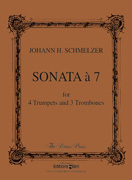Schmelzer, Johann Heinrich (Tennyson) Sonata a7
Brass Septets

-
Schmelzer, Johann Heinrich (Tennyson)
Sonata a7 (Tennyson) [403.00]
Baroque. Leopold I, who ruled Austria from 1658 to 1705, supported a large musical staff at the Imperial Palace in Vienna. Leopold was himself a musician and composer who enjoyed large musical spectacles. Many masses, requiems, and magnificats, as well as music for court ceremonies and festivals were scored to include large brass ensembles. The fact that competant wind and brass players were retained by the Emperor on a full time basis to provide music for many diverse functions is shown by employment records which have been preserved to this day. Johann Heinrich Schmelzer served at Leopold's court from 1649 until his death in 1680. During that period he rose from a chamber musician (violinist) to Capelmeister. As a composer Schmelzer contributed bothsacred and secular music for the Emperor's musical ensembles. His works include religious instrumental and vocal pieces, instrumental chamber compositions, and music for open-air festivals, such as the Royal Equestrian Ballets. The present edition is based on a manuscript in the castle archives of Kromeriz, Czechoslovakia, where Prince-Bishop Karl Liechtenstein-Castelcorn of Olmlitz maintained a fine court orchestra and chorus. The prince is also known to have borrowed composers from his Emperor in Vienna. [...] Score & parts. -Robert S. Tennyson The American University December, 1976 -
- Category: Brass Septets
- Item: 059258
- Grade/Level:
- Price: $32.95
-
(usually ships in 10 to 15 days)
